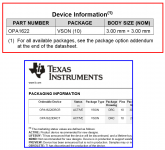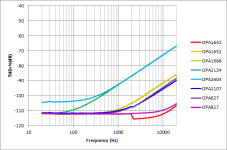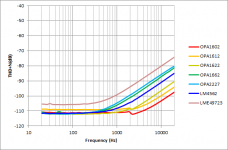I'm not familiar with that chip, but I recall that switching power supplies can have modes where they generate subharmonics well below the switching frequency, resulting in a filter being less effective than you might hope. If John's not that familiar with switchers (or even if he is), TI has a nice forum for discussing any of their parts here:
https://e2e.ti.com/
https://e2e.ti.com/
Hi John,
Do you have any experience with passive filter design?
I am planning on using TI's DCP010512BP isolated DC-DC converter to enable use of USB power (5V -> 12V) but would like to design a filter of some sort to cut down on voltage rail noise as this is a switching regulator. Granted it will be regulated with an LDO down to 10V to give a nice +-5V rail before it makes its way to the OPA1622, but a CLC filter or something similar in between would be nice.
The switcher has a switching frequency of 800khz, thus leading me to want to design an LC filter with a resonance frequency of around 80khz to keep the resonant point well out of the expected noise. Maybe a 47uH inductor with 0.1uF caps? As far as the proper impedance of the filter, I have no idea... 50 ohms?
Here's what I've got right now:
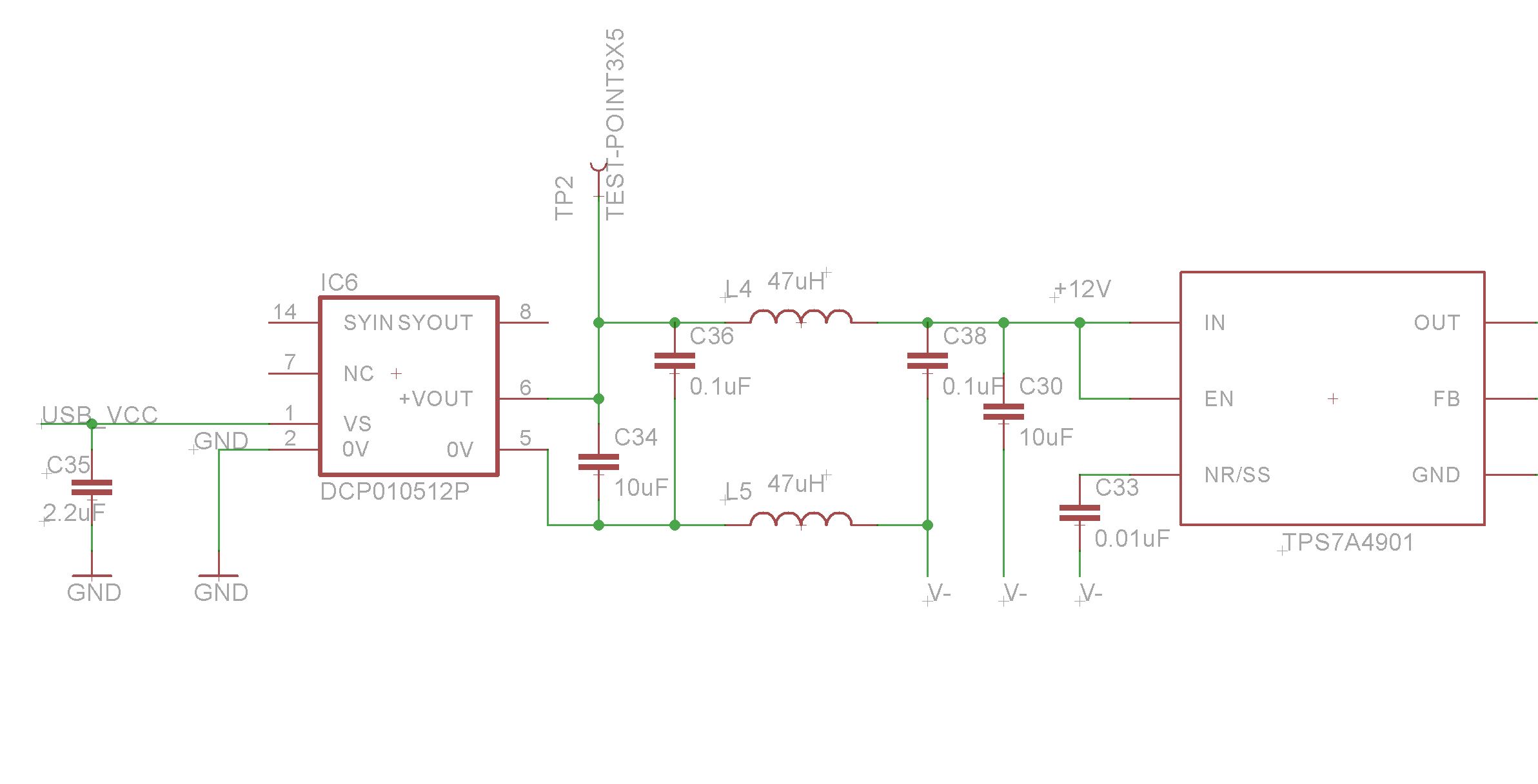
Thanks
Not really my area of expertise, and I would echo the recommendation to post questions onto the relevant forum on e2e.ti.com. However, I will point out that without any kind of lossy element in the CLC filter, it's going to ring like a bell with any perturbation (load step). A resistor in series with the 47uH inductor will kill the Q (50 ohms would work) and still leave enough headroom for the linear regulator.
For those interested, the 3rd part in our blog series on the development of the OPA1622 is now up on e2e: Amp up your cans: Test your headphone amplifier distortion knowledge (Part 3) - Precision Hub - Blogs - TI E2E Community
Parts 3 and 4 are specifically on distortion. Part 4 will be online next Friday (3/5)
Parts 3 and 4 are specifically on distortion. Part 4 will be online next Friday (3/5)
johnc124 - a bit OT, but in the link you posted above, the OPA1688. Could you confirm that chip is FET input? The input bias current and voltage noise specs would seem to say so, but I don't see FET specficially stated in the datasheet. I'm probably just overlooking it.
johnc124 - a bit OT, but in the link you posted above, the OPA1688. Could you confirm that chip is FET input? The input bias current and voltage noise specs would seem to say so, but I don't see FET specficially stated in the datasheet. I'm probably just overlooking it.
Technically, yes, because its a MOSFET-input device. The OPA1688 is fabricated on a low noise analog CMOS process.
johnc124 - thanks. The OPA1688 looks like it might be a viable alternative to the LME49880 since it is one of the few that is rated for low THD+N into 600R, good to 36V, and comes in SOIC8. I was comparing fig 11 in the LME datasheet with fig 16 in the OPA sheet. Same minimum level but the OPA remains more linear for larger output swings. No power pad but I see the tiny leadless version does have one.
Last edited:
The OPA1688 looks like it might be a viable ... good to 36V, and comes in SOIC8.
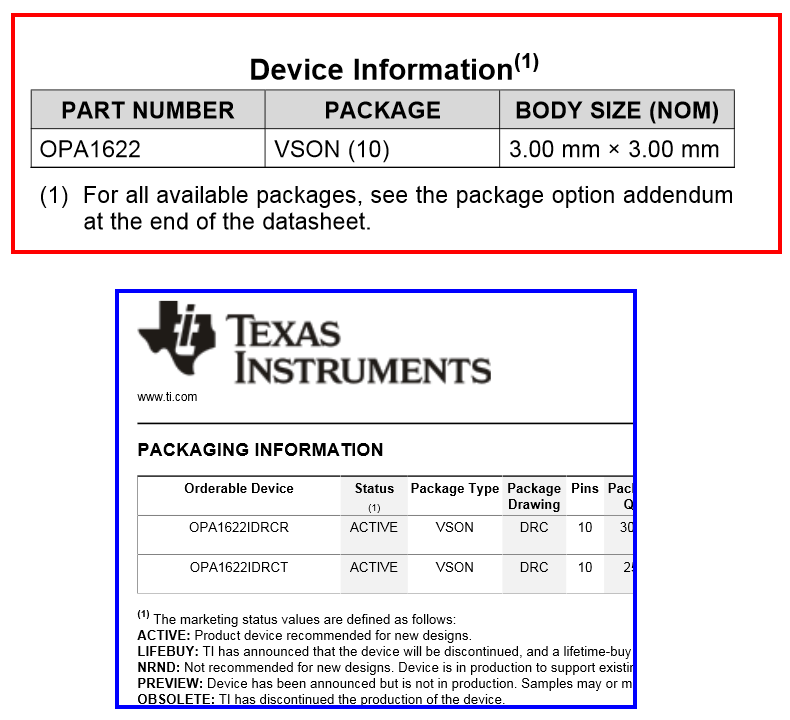
_
Attachments
Last edited:
johnc124 - thanks. The OPA1688 looks like it might be a viable alternative to the LME49880 since it is one of the few that is rated for low THD+N into 600R, good to 36V, and comes in SOIC8. I was comparing fig 11 in the LME datasheet with fig 16 in the OPA sheet. Same minimum level but the OPA remains more linear for larger output swings. No power pad but I see the tiny leadless version does have one.
The OPA1688 does great with 600R loads, and if you want more output current, you could always put 4 in parallel and have the same power supply current as an LME49880 😉 600 ohm loads shouldn't require a thermal pad. Maximum power dissipation on +/-18V supplies and a 600 ohm load would be about 110mW. The Theta JA for the SOIC package is 116.1 C/W, so you're looking at a 116.1 * .110 = 12.7 deg C temp rise over ambient.
The OPA1688 also has a much more stable input impedance than older JFET input parts, which reduces its distortion in non-inverting configurations with high source impedance. Attached is a comparison of JFET/CMOS op amps configured in a gain of +1, 10kOhm source impedance, and a 5Vrms input signal. Variations in the amplifier input impedance produce the additional distortion. Unfortunately, I haven't tested the LME49880 yet, but OPA1652 and OPA1688 are about on par with the older DiFET parts from Burr-Brown (OPA627, OPA2107). And the newer JFET parts from TI (OPA827, OPA1642) show the best performance. The dip in the THD+N curve for the OPA1642 is a range-switching effect on the Audio Precision and not the actual behavior of the op amp.
Attachments
The OPA1688 does great with 600R loads...
Thanks for the information! Yeah the LME49880's Iq is "not battery friendly". 🙂 In fact the (15V * 2) * 0.014mA = 420mW power dissipation just from the quiescent may be a big part of why they had to add the power pad in the first place.
My interest in driving 600R isn't even the headphones, but the pot and Rf. One project I have on the forum here uses a pot-in-the-middle design with a 1K pot and 1.5K feedback resistor for low(er) Johnson noise. 1.5K||1K = 600R. Part of the reason I did that was to take full advantage of that 600R drive capability of some of the LME parts. Good that you guys have some new OPA parts that can take the place.
Your graph made my day. 🙂 Another project I have here uses an OPA827 looped with a LME49600, +1 unity gain, non-inverting, 2.5K (maximum) effective source resistance, and 5Vrms = 7Vpeak on batteries. The buffer will add distortion, but still that curve for the OPA827 rocks. The buffer chip is to (also) allow driving low-sensitivity 16R headphone loads, something that would probably make the 1622 run away and hide. 😛 Your OPA1622 will be a great chip for driving modern high sensitivity cans/IEMs from portable gear. Which chip on the graph would you guess the OPA140/2140/4140 would be most similar to?
Last edited:
The OPA140/2140/and 4140 will perform identically to the OPA1641/42/44 in the graph I showed.
What kind of sensitivity do you consider low? I use the OPA1622 with my HE-560s (45 ohm, 90dB/mW) and it will reach ear-splitting levels. I've honestly never found a pair of headphones that actually required the insanely high power levels that many high fidelity headphone amplifiers claim to be able to deliver. The OPA1622 will do 80mArms linearly, which is over 100mW into 16 ohms.
What kind of sensitivity do you consider low? I use the OPA1622 with my HE-560s (45 ohm, 90dB/mW) and it will reach ear-splitting levels. I've honestly never found a pair of headphones that actually required the insanely high power levels that many high fidelity headphone amplifiers claim to be able to deliver. The OPA1622 will do 80mArms linearly, which is over 100mW into 16 ohms.
Last edited:
Part 4 of the blog series on the development of the OPA1622 is now online: Amp up your cans: Distortion in headphone amplifiers (part 4) - Precision Hub - Blogs - TI E2E Community
What kind of sensitivity do you consider low?
The AKG K1000 (now discontinued, but people on the forum here still use them), 120R at 74dB/mW. 🙂 Vrms and Irms calculation spreadsheets below. The HE6 and HE500 also come up a lot. I also have a headphone amp project here that can push 8 ohms, for use with electrostatic chargers meant to be hooked to speaker terminals. I believe there are a couple of 16R low-sensitivity IEMs out there too.
One important point here: what is considered "loud enough". 🙂
From a consumer standpoint, or any normal (and hearing-safe) listening experience, I quite agree 80dB SPL often does it and 90dB if one really likes to crank the volume up.
But here in audiophile land the figure that I've seen batted around the most over the years - the old Headwize forum, Head-Fi, and posts here - is 120dB SPL maximum for instantaneous peaks. That is the SP level on that chart at the bottom of the spreadsheets below showing "threshold of pain, 2 minutes maximum exposure". The audiophile thinking that I've usually seen posted is not an intent to listen at that level, even briefly, but rather that "adequate headroom in the amp sounds better". So now we've switched from objective to subjective. 🙂 There is also the issue of "music power" with real music (vs. sine wave testing) where the musical peaks can often top out at 2x or 3x the average signal level, which is probably where the amp "headroom" thinking got a start.
The first spreadsheet below is for the K1000 at 90dB. 2.19Vrms and 18mA(rms), with the OPA1622 probably being quite happy.
The second sheet is now at 100dB SPL. 6.9Vrms and 57mA(rms) per channel. NwAvGuy's popular O2 Headhone Amplifier project in the headphone forum here can do it on AC (+/-12Vdc rails, two parallel NJM4556A 75mA current buffers on each channel), but the OPA1622 would probably wind up in current/SOA limit (hopefully it has limiting? I haven't read the spreadsheet in detail).
The third sheet is with 110dB SPL. Now we are up to 22Vrms and 182mA. AMB's b22 headamp project can (almost, 20V) do it. There are probably other discrete headphone amps out there that can.
The K1000 is an extreme case. But the HE6 and HE500 are more common. Going over 90dB SPL with those would also likely exceed what the OPA1622 can do, from a bit of quick number-plugging into their spreadsheets.
I'm not knocking the OPA1622 at all! 🙂 From the specs it looks like an excellent chip for medium-to-high sensitivity cans (most anything modern made over the last few years and many/most legacy headphones and IEMs), portable (or desktop!) equipment and normal listening levels. But a few audiophiles may push back about powering extreme cans, or these extreme SPL "headroom" numbers.
Thank you for the reply about the OPA140/2140!
Attachments
Last edited:
The second sheet is now at 100dB SPL. 6.9Vrms and 57mA(rms) per channel. NwAvGuy's popular O2 Headhone Amplifier project in the headphone forum here can do it on AC (+/-12Vdc rails, two parallel NJM4556A 75mA current buffers on each channel), but the OPA1622 would probably wind up in current/SOA limit (hopefully it has limiting? I haven't read the spreadsheet in detail).
For a 120 ohm load, the OPA1622 is good for about 8Vrms, which would be 101dB SPL into a 74dB/mW headphone and would require +/- 13.5V supplies.
The OPA1622 does have thermal shutdown which kicks in when the die hits 175C but the power dissipation for this use case is only 308mW max. With the thermal pad soldered down, that would give a die temp rise of 15C over ambient. No worries about SOA here. I have a feeling I could get it to 9.6Vrms on +/-15.5V supplies, but will have to check on the AP later.
That's a pretty low sensitivity headphone for sure and I agree a single channel won't drive it to extremely loud levels in the transients.
HE-6 and HE-500 are much more efficient at 83.5 and 89 dB/mW respectively. A quick back of the envelope calculation predicts the OPA1622 could deliver 320mW to the HE-6, which would be 108.55 dB SPL. HE-500's 38 ohm impedance would probably result in 110.7dB SPL. So I'm not sure how you determined that the OPA1622 could not drive them above 90dB?
actually you only have to look at the Album list - Dynamic Range Database to see +23 dB peaks exist in music recordings
Home Theater THX calls for 85 + 20 = 105 dB for mains, + 10 dB more for sub-bass LFE
with all channels blasting, peaks over 115dB SPL are Standard in a THX calibrated Home Theater setup
Voltage swing can be extended with bridged op amps, do have to rewire the headphone "balanced" (as its called in the headphone audiophile world)
but if you are a numbers freak TRS compromises the crosstalk with the shared ground contact and you'd want "balanced" headphone cabling anyway
unfortunately no standard for the needed 4 pin connectors exist - 2x 3 pin XLR are clearly not a modern portable music player compatible solution
a sometimes bigger failing of the TRS is you can get shorting of the channels as the TRS is plugged/unplugged - some amps are known to lunch themselves if you do this with music playing loud
Home Theater THX calls for 85 + 20 = 105 dB for mains, + 10 dB more for sub-bass LFE
with all channels blasting, peaks over 115dB SPL are Standard in a THX calibrated Home Theater setup
Voltage swing can be extended with bridged op amps, do have to rewire the headphone "balanced" (as its called in the headphone audiophile world)
but if you are a numbers freak TRS compromises the crosstalk with the shared ground contact and you'd want "balanced" headphone cabling anyway
unfortunately no standard for the needed 4 pin connectors exist - 2x 3 pin XLR are clearly not a modern portable music player compatible solution
a sometimes bigger failing of the TRS is you can get shorting of the channels as the TRS is plugged/unplugged - some amps are known to lunch themselves if you do this with music playing loud
Last edited:
- Home
- Vendor's Bazaar
- New Audio Op Amp - OPA1622
